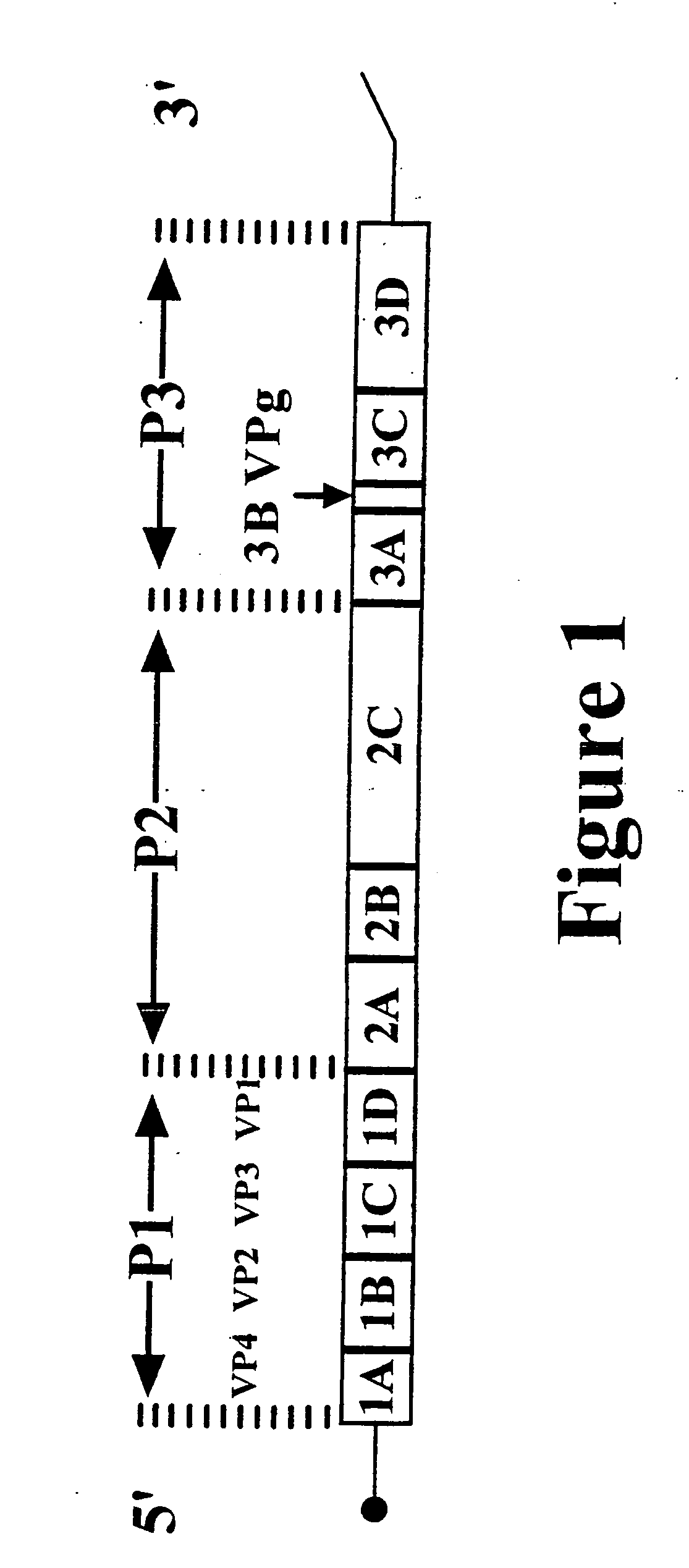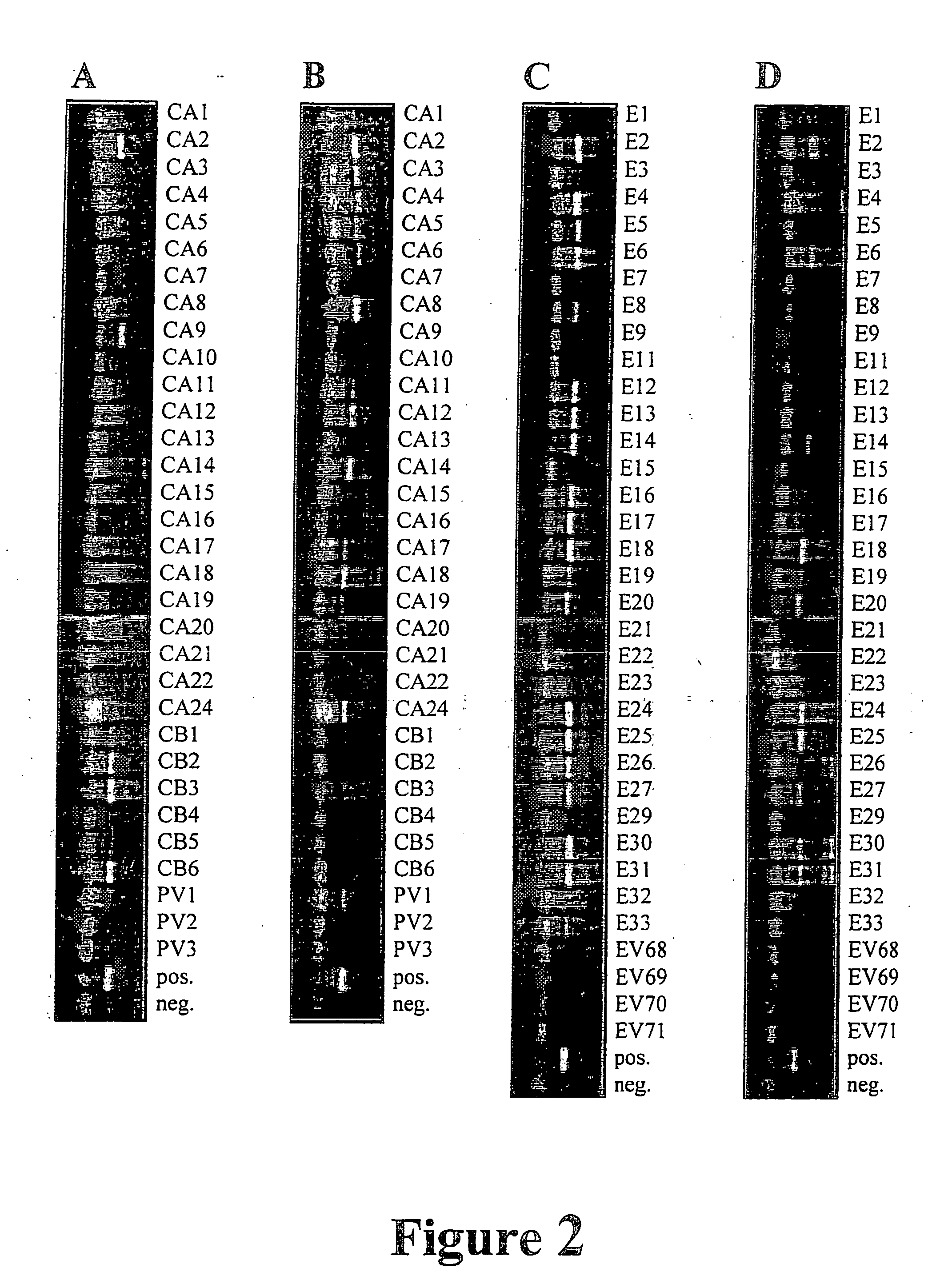Typing of human enteroviruses
a technology of enterovirus and human body, applied in the field of human enterovirus typing, can solve the problems of inability to grow in cell culture, inconvenient application of such a determination to a clinical sample, and high cost of culturing and classification procedures
- Summary
- Abstract
- Description
- Claims
- Application Information
AI Technical Summary
Benefits of technology
Problems solved by technology
Method used
Image
Examples
example 1
Establishing a Database of Sequences Corresponding to Standard Non-polio Enterovirus Serotypes.
[0084] The viruses used for sequence analysis are listed in Table 2, above. The prototypical virus samples were obtained from the American Type Culture Collection. The viruses were propagated in RD cells, HLF cells, LLC-MK2 cells, or primary monkey kidney cells using Eagle's MEM supplemented with 2% fetal bovine serum or by intracerebral inoculation of newborn mice (see Grandien, M., et al., “Enteroviruses and Reoviruses”, in Diagnostic procedures for viral, rickettsial, and chlamydial infections, 6th Ed. (Schmidt, N. J., et al., eds.) 1989, Amer. Public Health Assoc., Washington, D.C., pp. 513-578) . The isolation of the viral RNA, and the RT-PCR amplification was conducted as described by Oberste et al. (Am. J. Trop. Med. Hyg. 58:4146 (1998b)). In summary, in this procedure, viral RNA was extracted from infected cell culture supernatants, or from 10% infected mouse brain homogenate with...
example 2
Design of Non-Polio Enterovirus PCR Primers and Assessment of the Breadth of Their Specificity.
[0090] Design of PCR Primers.
[0091] Since the VP1 sequence was found to. correlate with serotype (Example 1), this region was targeted for development of sequence-based molecular diagnostics, namely, generic PCR primers to amplify and sequence a portion of the VP1 gene. Degenerate deoxyinosine-containing PCR primers were designed which specifically recognize regions within or near the termini of the VP1 gene of non-polio enteroviruses. Primers with the broadest specificity within the non-polio enterovirus genus were chosen by searching for regions in the genome that encode amino acid motifs within VP1 and those immediately C-terminal to VP1, in 2A, that are the most conserved across the prototypes. (Echoviruses E22 and E23 were excluded, because it is likely that they will be reclassified as members of a new Picomavirus genus, Parechovirus (Mayo et al., J. Gen. Virol. 79:649-657 (1997))....
example 3
Typing of Clinical Isolates Obtained in the Field.
[0094] Viruses.
[0095] Fifty-one virus isolates of 24 different serotypes were chosen from those processed in the inventors' laboratory at the Centers for Disease Control and Prevention (CDC) during the period 1991-1998 for routine non-polio enterovirus reference testing. The viruses were from 19 different states in the United States and two other countries, and were chosen to be representative of the serotypes in the collection for the period surveyed. To avoid the effects of sampling bias in the interpretation of sequence comparisons, no more than four isolates of any given serotype were chosen for sequencing. The isolates included examples of coxsackievirus A, coxsackievirus B, echovirus, and numbered enteroviruses.
[0096] Virus Isolation and Neutralization.
[0097] The virus strains were isolated from a wide range of clinical specimens, including blood (n=1), cerebrospinal fluid (n=7), conjunctival swab (n=1), “lesion” (n=1), pos...
PUM
| Property | Measurement | Unit |
|---|---|---|
| Fraction | aaaaa | aaaaa |
| Fraction | aaaaa | aaaaa |
| Fraction | aaaaa | aaaaa |
Abstract
Description
Claims
Application Information
 Login to View More
Login to View More - R&D
- Intellectual Property
- Life Sciences
- Materials
- Tech Scout
- Unparalleled Data Quality
- Higher Quality Content
- 60% Fewer Hallucinations
Browse by: Latest US Patents, China's latest patents, Technical Efficacy Thesaurus, Application Domain, Technology Topic, Popular Technical Reports.
© 2025 PatSnap. All rights reserved.Legal|Privacy policy|Modern Slavery Act Transparency Statement|Sitemap|About US| Contact US: help@patsnap.com


